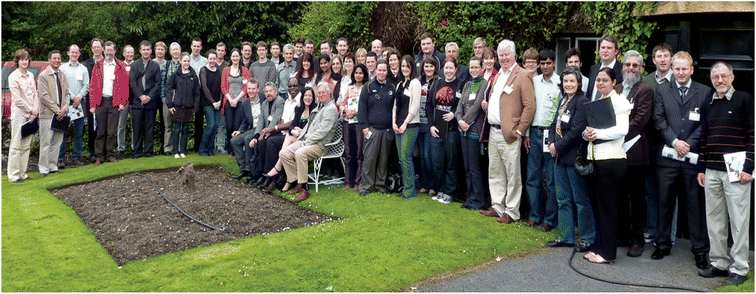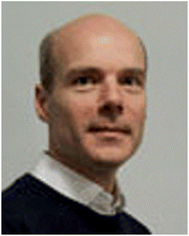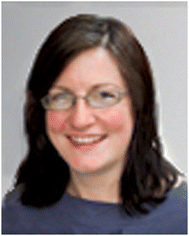Editorial – Future Electroanalytical Developments
In recent months, you may have noticed that articles in Analyst and Analytical Methods have been placed together online under the title of “Future Electroanalytical Developments”. The idea for this web-based theme came from the organisers of the Eirelec '11, a conference which looked at what the future held in store for the field of electrochemistry. In this editorial, Professor Robert Forster and Dr Blánaid White of Dublin City University present an overview of the meeting. Our thanks go to Eirelec and to all the authors who have since contributed to this collection of important developments and novel applications in the exciting area of electroanalytical science.In 2011, Eirelec returned to Adare, Co. Limerick, the place where it all began in 1993 with some outstanding talks from outstanding scientists like Prof. Allen Bard, Prof. J. O'M Bockris and Prof. J Wang. And so, on May 16, more than 80 scientists with diverse interests in solving challenging electrochemical problems in fresh, high impact ways, gathered to discuss recent advances and to contemplate the future of the field. Delegates discussed the possibilities for electrochemistry for the future in sessions examining “Nano and Analytical Electrochemistry”, “Physical Electrochemistry” and “Electrochemical Materials and Sensors”. The diversity of these researchers, from biologists to nano-scientists, spoke to the tremendous power and influence of electrochemistry as a fundamentally interfacial science both in terms of its science and its scientists (Fig. 1).
 | ||
| Fig. 1 A group photograph of most of the conferees at Eirelec '11 outside the Dun Raven Arms Hotel. | ||
We were honoured to have three exceptional plenary speakers who described some of the latest breakthroughs in modern, interdisciplinary, electrochemistry. Professor Joseph Wang of the University of California, San Diego described electrochemically-propelled nanomachines for biomedical and bioanalytical applications. This enthralling talk described the rational design, fabrication and application of nanomachines in microfluidics and sensing. Professor Patrick Unwin of the University of Warwick presented a fascinating lecture describing recent accomplishments in electrochemical imaging capable of high resolution flux measurements. This excellent talk covered new imaging techniques, elucidation of structure and function and applications, for example, understanding what controls crystal growth. Professor Craig Lunte of the University of Kansas spoke eloquently about electrochemical detection for capillary electrophoresis and demonstrated some outstanding enhancements of analytical performance in terms of dynamic range, sensitivity and limits of detection of biologically important molecules. Contributed oral and poster presentations described the latest findings in areas ranging from nanosensors, biomedical and bioanalytical applications, novel materials and genosensors to advanced theory, illustrating the expertise and potential of established and emerging electrochemists across Ireland and internationally.
Last year, 2011, was the United Nations International Year of Chemistry and it was also important to reflect on the role that electrochemistry plays in modern science and to contemplate the field’s future. The first Eirelec meeting focused on the two cultures of physical chemistry and electroanalysis and their futures as we approached the year 2000! Much has changed since 1993, and the 2011 meeting acknowledged that the discipline needs to carefully preserve its distinct expertise and identity, particularly through undergraduate teaching programmes. However, attendees at the round table discussion about the future of electrochemistry were struck by the awareness of delegates about all they could contribute in a meaningful way to the overall scientific community. This conference was united in the view that the success of the field will continue by playing an increasingly central role in nanoscience, biomedicine and energy research well beyond the traditional roles and borders of the field. As the Irish sheanfhocal says “Trí na chéile a thógtar na cáisléain” or “Together, we can build castles”, and electrochemists are unusually open to embracing new challenges and bringing their expertise to bear on long-standing problems in other disciplines. Moreover, the prospects for social and economic impact have never been greater and we look forward to nanomachines, molecular electronic devices, energy sources, sensors and imaging tools coming to the market by the time the next Eirelec meeting is held.
And so the meeting closed with a session dedicated to Professor Malcolm Smyth of Dublin City University on the occasion of his 60th birthday, where the diversity and scope of his research in DCU were showcased in presentations from both collaborators and former and present research group members. Malcolm has been a central figure, perhaps the central figure, in electroanalysis in Ireland for more than three decades. According to an old Irish saying, “Ní fiú scéal gan údar” or “There's no worth to a story without an author”. Through his scientific research, his students, his work in building a strong university relevant to the needs of modern society, as well as his outreach to the broader community (including singing “The Wild Rover” at 3.00 am!) he has written a great inspirational novel. We wish him well in the coming years whatever the next adventure may be!
The papers contained in this themed issue will also convey a flavour of the meeting to those who could not attend. In keeping with Eirelec tradition, Professor Mike Lyons conducted interviews with the Plenary Speakers Prof. Wang and Prof. Unwin, which can be found on the Analyst blog (http://blogs.rsc.org/an), which add further insight into the potential for electrochemistry in the future. (The views expressed in these interviews are specific to the people concerned.) The conference organising committee wish to thank the Royal Society of Chemistry and the Editor of Analyst and Analytical Methods for agreeing to produce a web-based themed issue.
So what of the future of electrochemistry? In these times, where conducting scientific research must be balanced against diminishing resources, electrochemistry can provide meaningful tools, techniques and answers of scientific merit. The authors look forward to the fourth Eirelec meeting, to discover if we achieve our potential.
| This journal is © The Royal Society of Chemistry 2012 |


